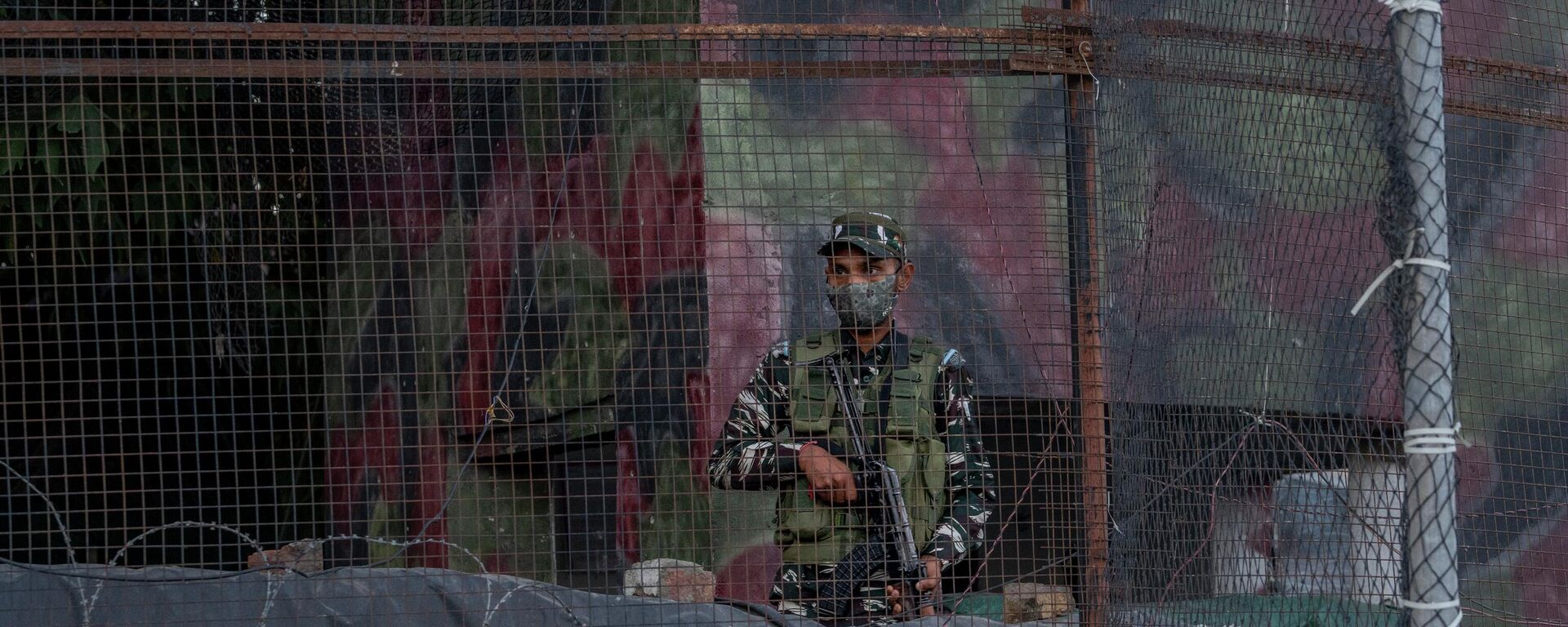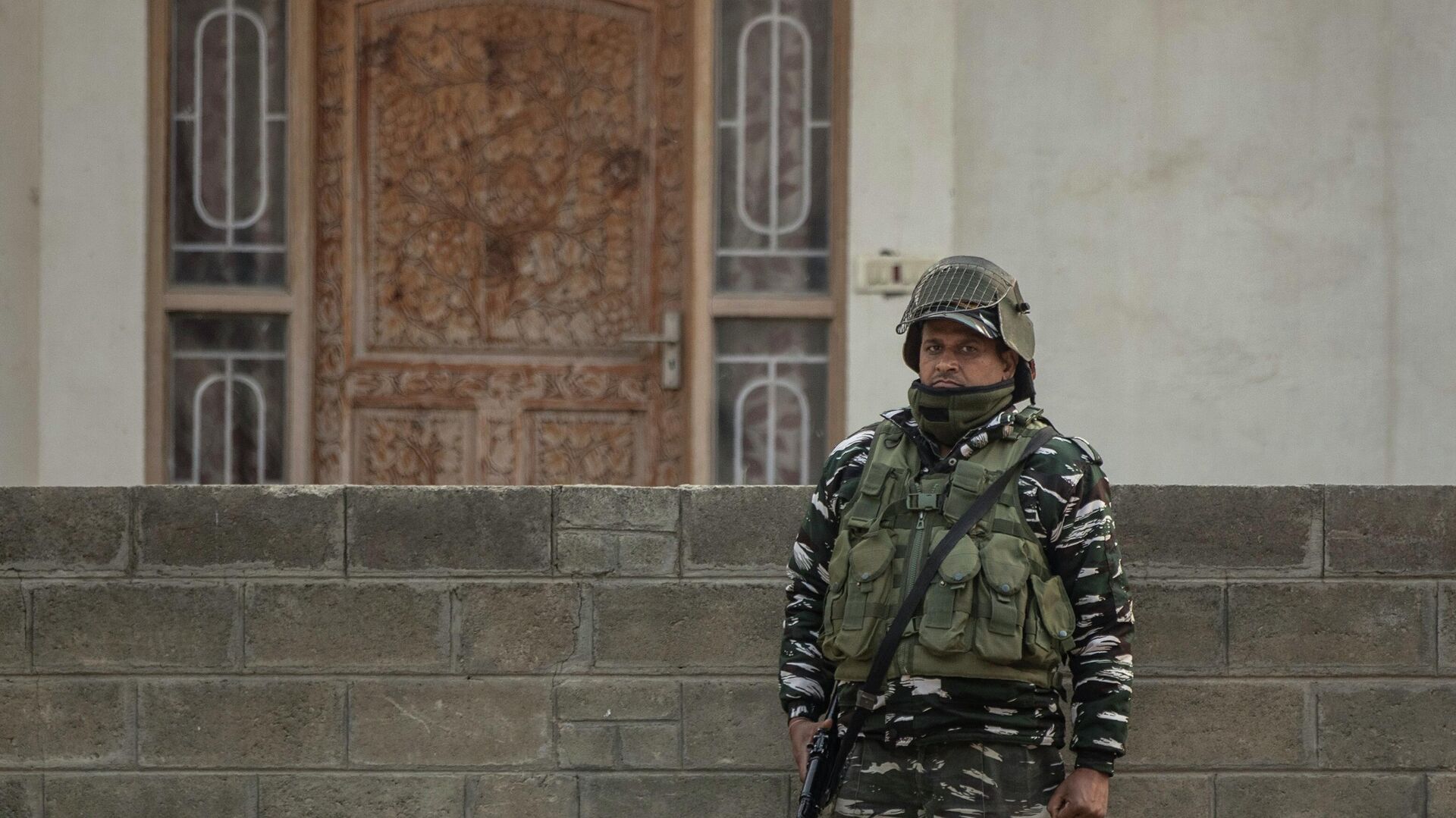https://sputnikglobe.com/20221018/narrative-war-militants-in-kashmir-target-civilians-to-sow-panic--earn-more-news-coverage-1102009183.html
'Narrative War': Militants in Kashmir Target Civilians to Sow Panic & Earn More News Coverage
'Narrative War': Militants in Kashmir Target Civilians to Sow Panic & Earn More News Coverage
Sputnik International
In the late 1980s, a massive insurgency erupted in Jammu and Kashmir: militant ranks were prominently filled by local Kashmiri Muslims and foreign cadres from... 18.10.2022, Sputnik International
2022-10-18T14:35+0000
2022-10-18T14:35+0000
2022-10-18T14:35+0000
jammu
kashmir
conflict between india, pakistan escalates over exchange of airstrikes in kashmir
india
https://cdn1.img.sputnikglobe.com/img/07e6/0a/12/1102012844_0:148:3115:1900_1920x0_80_0_0_b91f739b8ca894b932a1799895054c79.jpg
Two weeks after Indian Home Affairs Minister Amit Shah visited Jammu and Kashmir and noted that militancy in the region had been declining in recent years, a fresh spike in violence is being witnessed again in Kashmir. Shah’s remarks followed a statement made last month by Jammu and Kashmir Director General of Police Dilbag Singh that militancy in Kashmir was “on crutches.”Indeed, government data regarding various insurgency parameters -- such as the number of civilians and security personnel killed and the number of attacks by militants -- suggests that violence in the region has been on a steady decline, as was witnessed in 2007-08, and then again from 2010-14.But these troughs of peace have been interspersed with spikes of violence, too, such as recent cases in which two outstation laborers and a Kashmiri Hindu were killed in just three days.A senior police officer told Sputnik on condition of anonymity that militants have realized that killing civilians whom they accuse of being sympathetic to the government, as well as minorities and especially non-local residents, serves them more than attacking security encampments or killing police officers and army troopers. A senior official of the army told Sputnik that about 120 to 130 militants, including foreigners, are suspected to be operating in the region and that this is the lowest figure in almost a decade.Ajai Sahni, director of the Delhi-based Institute for Conflict Management, however, opined that the current spate of violence in Kashmir is not a spike, but residual militancy.He said the attacks are meant to achieve small successes by residual threats. He suggested: "What Kashmir needs is a political resolution. Talking to Kashmiris is paramount, only then can the threat to civilians be removed.” Similar violent spikes were witnessed in 2010 and 2015, when scores of educated local youth joined militant ranks, and the killing of one such militant commander, Burhan Wani, in 2016 led to nearly six months of protests and shutdowns.As per the federal government, the current decrease in violence on average has been achieved due to the removal of Kashmir's special status, which had disallowed non-local residents from purchasing land, vote in local elections, and acquire government jobs.
https://sputnikglobe.com/20221017/kashmiri-pandits-call-on-muslim-clerics-to-protest-civilian-killings-by-militants-operating-in-jk-1101918493.html
jammu
kashmir
Sputnik International
feedback@sputniknews.com
+74956456601
MIA „Rossiya Segodnya“
2022
Azaan Javaid
https://cdn1.img.sputnikglobe.com/img/07e6/03/19/1094183852_0:0:1080:1080_100x100_80_0_0_1fd4d8740a02742b3f72f82306742213.jpg
Azaan Javaid
https://cdn1.img.sputnikglobe.com/img/07e6/03/19/1094183852_0:0:1080:1080_100x100_80_0_0_1fd4d8740a02742b3f72f82306742213.jpg
News
en_EN
Sputnik International
feedback@sputniknews.com
+74956456601
MIA „Rossiya Segodnya“
Sputnik International
feedback@sputniknews.com
+74956456601
MIA „Rossiya Segodnya“
Azaan Javaid
https://cdn1.img.sputnikglobe.com/img/07e6/03/19/1094183852_0:0:1080:1080_100x100_80_0_0_1fd4d8740a02742b3f72f82306742213.jpg
jammu, kashmir, conflict between india, pakistan escalates over exchange of airstrikes in kashmir, india
jammu, kashmir, conflict between india, pakistan escalates over exchange of airstrikes in kashmir, india
'Narrative War': Militants in Kashmir Target Civilians to Sow Panic & Earn More News Coverage
In the late 1980s, a massive insurgency erupted in Jammu and Kashmir: militant ranks were prominently filled by local Kashmiri Muslims and foreign cadres from Pakistan. The insurgency ebbed over the years amid global focus on the events and an effective counter strategy by the Indian security establishment.
Two weeks after Indian Home Affairs Minister Amit Shah visited Jammu and Kashmir and noted that militancy in the region had been declining in recent years, a fresh spike in violence is being witnessed again in Kashmir.
Addressing a public rally, Shah said that since August 2019, when the federal government revoked Jammu and Kashmir’s semi-autonomous status, only 721 militancy-related incidents were recorded in Kashmir, compared with 4,766 violent incidents between 2006 and 2013.
Shah’s remarks followed a statement made last month by Jammu and Kashmir Director General of Police Dilbag Singh that militancy in Kashmir was “on crutches.”
Indeed, government data regarding various insurgency parameters -- such as the number of civilians and security personnel killed and the number of attacks by militants -- suggests that violence in the region has been on a steady decline, as was witnessed in 2007-08, and then again from 2010-14.
But these troughs of peace have been interspersed with spikes of violence, too, such as recent cases in which two outstation laborers and a Kashmiri Hindu were killed in just three days.
Speaking to Sputnik, security officials suggested that militant groups are likely to escalate violence in the coming months against what are considered “easy targets” -- namely, civilians, minorities, and non-local residents. Meanwhile, the insurgents' strategy is not aimed at achieving a higher fatality rate, but rather at controlling their own narrative on Kashmir.

17 October 2022, 10:41 GMT
A senior police officer told Sputnik on condition of anonymity that militants have realized that killing civilians whom they accuse of being sympathetic to the government, as well as minorities and especially non-local residents, serves them more than attacking security encampments or killing police officers and army troopers.
"It is a narrative war, and what militants are telling us, besides making their presence be felt, is that they will not allow outsiders to settle in Kashmir,” the officer said. “Targeting outsiders or individuals whom they suspect of enabling demographic changes to Kashmir earns them more news coverage. It spreads equal or even more fear than fidayeen (suicide) attacks.”
A senior official of the army told Sputnik that about 120 to 130 militants, including foreigners, are suspected to be operating in the region and that this is the lowest figure in almost a decade.
“The violence may be fallout of the recent announcement by the Home Minister that elections will be held in Kashmir which is a sign of normalcy," he said, adding that: "Militants would not like any semblance of normalcy to return to Kashmir.”
Ajai Sahni, director of the Delhi-based Institute for Conflict Management, however, opined that the current spate of violence in Kashmir is not a spike, but residual militancy.
“The recent violence is not necessarily an outcome of recent statements by top government functionaries or police officials. The trajectory shows that violence has decreased."
He said the attacks are meant to achieve small successes by residual threats.
"But there is a powerful outsider (Pakistan) force which will not let go of its fundamental Kashmir policy, which is to back militancy," Sahni told Sputnik.
He suggested: "What Kashmir needs is a political resolution. Talking to Kashmiris is paramount, only then can the threat to civilians be removed.”
Similar violent spikes were witnessed in 2010 and 2015, when scores of educated local youth joined militant ranks, and the killing of one such militant commander, Burhan Wani, in 2016 led to nearly six months of protests and shutdowns.
As per the federal government, the current decrease in violence on average has been achieved due to the removal of Kashmir's special status, which had disallowed non-local residents from purchasing land, vote in local elections, and acquire government jobs.



